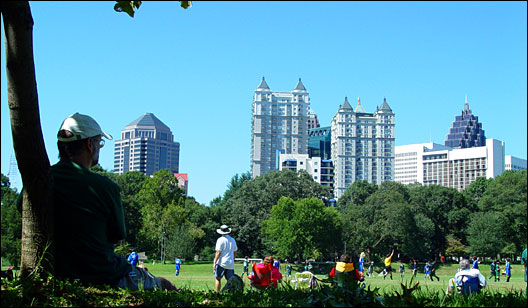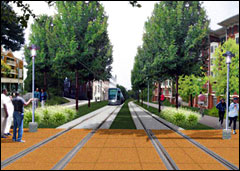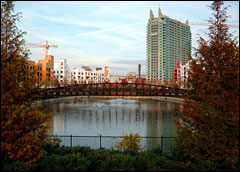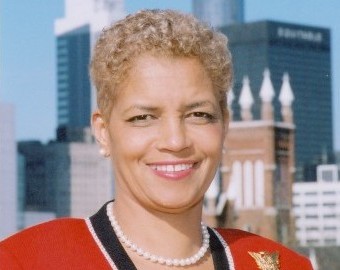 The City in the Forest hopes to get back to its roots.Despite its reputation as a city of wall-to-wall subdivisions, office complexes, and shopping centers, Atlanta’s not a complete stranger to matters of green. At the time of its mid-19th century founding, in the woods at the end of a railroad line, it was called the “City in the Forest.” And in the early 20th century, the city created the 185-acre Piedmont Park in Midtown (currently ballooning to add another 50 acres).
The City in the Forest hopes to get back to its roots.Despite its reputation as a city of wall-to-wall subdivisions, office complexes, and shopping centers, Atlanta’s not a complete stranger to matters of green. At the time of its mid-19th century founding, in the woods at the end of a railroad line, it was called the “City in the Forest.” And in the early 20th century, the city created the 185-acre Piedmont Park in Midtown (currently ballooning to add another 50 acres).
Since then, of course, the Atlanta of urban planning lore has descended: traffic-choked, overdeveloped, polluted, with a major water crisis and few public transportation options, in a state where 100 acres of open space are gobbled up every day. And while the city has certainly earned that reputation — Atlanta was ranked the fourth-most-sprawling of 83 metro areas by Smart Growth America — a greener Atlanta, one that jibes with its bucolic roots, is peeking from behind the veil of smog, giving the city both an environmental makeover and an economic boost.
“Atlanta has gotten so much recognition about being the poster child for sprawl and its legendary love affair with the car,” says Will Herbig, director of urban design at Midtown Alliance, which has spearheaded the revitalization of one of the city’s core neighborhoods. “We’ve all realized the status quo cannot continue. There’s got to be another way.”
The city’s new way includes public transportation, with a 22-mile BeltLine project in the works that combines light rail with new pedestrian and bike links; a heavy investment in green building, with the LEED-heavy Emory University campus and the Southface Energy Institute setting new standards for sustainable construction; walkable neighborhoods and mixed-use development; and green-friendly policy, courtesy of Mayor Shirley Franklin. “It’s a market advantage for Atlanta to be green when competing with other cities in the region,” Herbig says.

Backers of the BeltLine hope the transit project will “boost economic vitality.”
Photo: atlantaga.gov
But for the legions of drivers stuck in rush hour traffic every day — Atlanta ranks fifth on the list of most congested U.S. cities, with peak driving times 46 percent longer than during off-hours — or for the millions watching their lawns wither due to the severe water shortage — the city and its suburbs continue to enforce various restrictions on outdoor water use — Atlanta’s shade of green needs to get a whole lot deeper.
LEEDing the Way
Long before LEED was on the tip of every architect’s tongue, the nonprofit Southface Energy Institute was helping the Southeast, and then the country, rethink the way they build. Their EarthCraft House green building program, started in 1999, offers a blueprint for energy- and resource-efficient practices with a laundry list of criteria, including site plan, energy efficiency, waste management, and ventilation. It’s a sort of local LEED — albeit one that’s gained national attention — that has now been used in more than 5,500 single- and multifamily homes, with another 9,000 in the pipeline.
But LEED itself is alive and well in the city, too. Atlanta ranked first on SustainLane’s U.S. City Rankings in the green building category in 2006, and requires all city buildings to achieve the LEED silver rating. The local university, Emory, welcomed the South’s first LEED-certified building in 2001, and green building is springing up all over town.
“Tenants want to be in a building that’s been designed from a sustainable point of view,” says Bob Hughes, a principal at HGOR, an Atlanta planning firm. He says 80 percent of the firm’s projects are seeking some form of LEED certification.

Atlantic Station, the city’s biggest smart-growth success so far.
The city’s best known green building project is Atlantic Station, a mixed-use complex rising on the site of a former steel mill that’s been widely hailed as a successful merging of development and economic interests. When fully built out in the next decade, this city-within-a city will include six million square feet of LEED-certified office space; 5,000 high-rise, loft-style units, townhouses, and single-family residential homes; nearly two million square feet of retail; and 1,000 hotel rooms. Since Atlantic Station opened in the fall of 2005, its developers have realized the first half of their vision, with some 3,000 residents and 5,000 people occupying the offices, restaurants, and shops — including what they call the “most urban” IKEA in the country.
The complex was designed so people can leave their cars parked. Instead, they can bike on a dedicated lane, walk, or use the free “rubber” trolley, which carries 60,000 people a month to and from a nearby transit site. A commuter café is intended as a hub from which people can find out about mass transit, car- and bike-sharing, and other commuting options. There’s also a spot reserved for light rail service, should funding allow the BeltLine to be expanded there.
While the concept of adaptive reuse is certainly battle-tested, for Atlanta, the project broke new ground. “We wanted to try not to reinvent the wheel,” says Brian Leary, vice president of design and development for Atlantic Station and one of the project’s chief architects. “We went to neighborhoods around the country and tried to unravel the DNA of those urban places and figure out what worked … that’s what was incorporated into the idea of Atlantic Station.”
Innies and Outies
Such inner city, sprawl-reversing initiatives were hard-won, and required both the citizenry and the development community to undergo an ideological makeover. “We still have people who think the way to deal with growth is to require large building lots, [but] all that does is spread out development, and the infrastructure costs,” says Dennis Creech, cofounder and executive director of Southface. “No one has ever come back from Paris and said, ‘That city is too dense.’ … We have to ask ourselves, are we designing for cars or people?”
Thanks to the efforts of the Midtown Alliance, a 30-year-old nonprofit, Atlanta’s Midtown neighborhood has proved that people-centered design can thrive here. Although the area had location in its favor — it’s just a half-mile from the city’s center — as well as rich institutional resources (the High Museum, the Atlanta Symphony’s concert hall, and Georgia Tech), by the late-1980s, nearly two-thirds of its buildings were vacant or little used. The area was rife with homeless people and drug addicts. The addition of a heavy rail line and the construction of the 50-story One Atlantic Center, now the third-tallest building in the city, brought in thousands of office workers — a boost, to be sure, but only during the workday.
It wasn’t until 1997, when the Midtown Alliance developed a master plan to foment infill development, that things really began to turn around. Midtown now has 13,000 housing units in the planning stages, and the thriving, walkable neighborhood has welcomed 10,000 residential units now housing 56,000 residents.
The neighborhood revival was greatly aided by a 2000 rezoning that prioritized transit and pedestrian access over accommodating the car. The plan did away with requirements that had forced developers to place parking between streets and buildings, allowing developers of mixed-use projects near transit centers to leave out parking completely — and making the BeltLine all the more key to the city’s reinvention.
Tightening the Belt
Of course, if you’re going to take parking off the docket, you’ve got to offer an alternative, and if you’re going to try to retrain a car-addicted citizenry, that alternative better be stellar. “If you try to solve a city for the automobile, you will never solve it,” Hughes says. Enter the BeltLine Project, 22 miles of light rail transit and a proposed Peachtree Streetcar route, added to a network of sidewalks, road improvements, and more than 1,200 acres of green space.
Eventually the BeltLine could help connect the dots between Atlantic Station and other major developments, including about 5,600 units of affordable housing that are planned around its proposed network of stations. The city also is trying to take charge of gridlocked traffic with the Connect Atlanta Plan; over the next year, they’ll develop a comprehensive assessment of transportation needs and offer a blueprint for future solutions.
But some major hurdles remain for the BeltLine, especially in its money belt. The state has yet to dedicate a stream of funding for mass transit, and in February the Georgia Supreme Court ruled against funding the BeltLine with $850 million in school taxes because such a use violates the state constitution. Voters statewide in November will be asked to decide whether the use of school tax money for so-called Tax Allocation Districts, which helped provide subsidies for Atlantic Station and other projects, should be allowed.
“If you look at Atlanta, it’s the only major mass transit system in the country that doesn’t have significant support at the state level,” says Southface’s Creech. “It’s crazy — we’re the economic engine for the state and region, and we’re getting killed by traffic, yet we don’t invest in alternatives.”
But if the suburbs around Atlanta are any indication, attitudes may be shifting in the state — at least somewhat. About an hour southwest, the Callaway Gardens resort will host 1,400 EarthCraft-certified and LEED-silver commercial buildings in village-like clusters in a 13,000-acre natural preserve. The development also has reduced its golf course from 63 holes to 36 as part of its effort to boost biodiversity by replacing grass with native plants. Elsewhere in the Atlanta suburbs, places like Woodstock Town Center, Norcross, and Decatur are incorporating sustainability into their master plans.
Of course, the shift isn’t all altruism; it’s good business, too. “We cannot keep up with the demand [for sustainable housing] despite a terrible real estate market,” says Edward C. Callaway, chair and CEO of the Ida Cason Callaway Foundation, one of Callaway Gardens’ developers. “[This kind of development] makes money, and it’s great for the environment, and it’s good for people.”
The Government Greens Its Own House
While the private sector has been busy greening itself, the city government has been playing catch-up. “Atlanta hasn’t had as clearly an identifiable public leader,” says Carl Smith, CEO of the Greenguard Environmental Institute, which certifies green building materials and products. “We’ve seen many good unconnected initiatives that sprung up, despite ourselves.”
Many in the city look to the folks at Emory University for inspiration. The university, whose 700 acres include the Centers for Disease Control and Prevention and multiple medical facilities, as well as classroom buildings, residence halls, and other facilities, was ahead of the private sector in formulating a long list of sustainable practices for every aspect of its campus. That list started with the land itself, of which only 46 percent can be used for development.
“As has been true to a large degree nationally, the first people making the shift were academic institutions,” says planner Bob Hughes. “Emory has been making a big push that way for a number of years.”
But in some cases, the city is actually taking the lead. One key figure helping Atlanta transition from energy and land glutton to a model of sustainability is Lynnette Young. The city’s former chief operating officer left her job last summer to helm Sustainable Atlanta, a new public-private initiative funded by a $1.5 million grant from the Kendeda Fund to help city government, along with local business and the community at large, green up its act. “We’re going to be led by experts, or providing incentives to attract green businesses to make Atlanta the Silicon Valley of green industries,” Young says.
Having commissioned a study on 10 cities’ best green practices, Sustainable Atlanta is formulating Green Compact, a set of voluntary sustainability benchmarks covering areas including water consumption, energy usage, and recycling for government and the private sector. Under Mandy Schmitt, a former consultant on green issues and now director of sustainability for the city, Atlanta is already implementing a range of practices recommended by Sustainable Atlanta in its government buildings.
 Atlanta Mayor Shirley Franklin.photo: atlantaga.govAnd Mayor Franklin, whose term ends in 2010, seems determined to leave sustainability as her legacy. In 2005, Franklin was among the first to sign on to the U.S. Conference of Mayors Climate Protection Agreement. She also addressed long-standing water, sewer, and storm drain management problems with a $4 billion overhaul.
Atlanta Mayor Shirley Franklin.photo: atlantaga.govAnd Mayor Franklin, whose term ends in 2010, seems determined to leave sustainability as her legacy. In 2005, Franklin was among the first to sign on to the U.S. Conference of Mayors Climate Protection Agreement. She also addressed long-standing water, sewer, and storm drain management problems with a $4 billion overhaul.
“The current mayor has a high ratio of talk to action,” Herbig says. “Administration after administration kept putting off the investment in infrastructure in water and sewer. She actually tackled that. How many mayors get standing ovations for raising taxes and tackling the sewer problem?”
Hold the Applause
Atlanta’s government, private, and nonprofit sectors finally seem to be clicking on all green cylinders by following through on a powerful combination of sustainable planning, forward-thinking building practices, transit-oriented design, and conservation practices like recycling and better energy management.
Still, enormous challenges remain. The region’s unchecked growth has put a severe strain on its energy, transportation, and water systems. “We face particular challenges as one of the fastest-growing regions of the country that’s heavily car-dependent, whose energy comes from coal-fired power plants, and as the largest municipality with the smallest watershed in the United States,” says Ciannat M. Howett, Emory’s director of sustainability initiatives. Georgia Power, the local utility, offers no incentives for creating energy alternatives.
Despite the obstacles in front of and all around them, Howett and Atlanta’s other green crusaders hold out hope that their collective work will have an impact — eventually. “It’s still a much tougher message, once you get into a statewide context,” Howett says. “But even there, in terms of general consciousness, it’s improving.”


